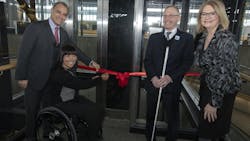Partnerships and renovations make VIA Rail's Ottawa Station its most accessible
VIA Rail Canada unveiled renovations made to Ottawa station on Feb. 6 that now makes the station the most accessible on its network and, according to the railroad, reflects its commitment to achieving universal accessibility for all Canadians.
The renovations made at Ottawa station were done in collaboration with the International Union of Railways (UIC) and provide a proof of concept to enable blind and partially-sighted passengers to navigate the station from entrance to platform autonomously.
“Renovations like those at VIA Rail’s Ottawa Station are crucial to improving accessible travel for all Canadians. I’m happy to see the principles behind our government’s proposed Accessible Canada Act being embraced. By working together, we can identify, remove and prevent barriers in a number of priority areas – ensuring we are inclusive by design,” stated Kate Young, Parliamentary Secretary to Minister of Public Services and Procurement and Accessibility.
VIA Rail and UIC conducted tests on a combination of two technologies enabling passengers with visual impairments to navigate by receiving audio indications as to the station’s environment. With the help of a smartphone and a GPS-like system, participants were able to navigate between the station entrance and the boarding platform autonomously. The Ottawa station was one of two stations in the world to participate in the pilot project, the other being owned by SCNF in France.
The tests were carried out in close collaboration with the Canadian Council of the Blind and the Canadian National Institute for the Blind. In light of the results of the pilot project, VIA Rail intends to perfect these new tools and is developing a plan to deploy this innovative technology in other stations in its network. VIA Rail says its stations would be the first in Canada to offer such cutting-edge technology and, thus, greater accessibility for everyone.
“With the Ottawa station, rail car renovations and new rail fleet, we were not just asked to help advise in the process but ultimately to teach the VIA Rail team, who overwhelmingly sought out our suggestions, praising the points we raised as both positive and necessary feedback. VIA Rail quickly recognized that as blind and visually-impaired people, we were living the experience and truly understood the meaning of accessibility. It is with utmost gratification that we acknowledge being treated with dignity and respect throughout the process. We never doubted that we were a valued part of the team. We see the results as an outstanding achievement of that process,” said Jim Tokos, national vice president, Canadian Council of the Blind.
Last year, VIA Rail carried nearly 4.8 million passengers, many of whom have limited mobility, vision or hearing. In order to provide service that meets their needs, VIA Rail invested more than C$162 million (US$121.88 million) since 2010 to make its trains and facilities more accessible.
The C$15 million (US$11.29 million) in renovations began in 2016 and included the installation of two elevators between the station and the boarding platforms, as well as the construction of a heated, tactile boarding platform with an access ramp, at level with the train door for ease of boarding and detraining of passengers
VIA Rail said it would continue the transformation of Ottawa station through the renovation and expansion of its Business Class lounge in order to make it fully accessible. Work is scheduled to begin in summer 2019.
“VIA Rail offers the most accessible intercity mode of transportation in Canada. The facilities...are part of our commitment to offer to all Canadians a safe and efficient mode of transportation between the cities of our vast country. In addition, we will pursue our efforts to not only meet, but surpass the requirements of Bill C-81 aimed at making Canada a barrier-free country,” said Yves Desjardins-Siciliano, president and chief executive officer of VIA Rail. “What’s more, we are developing a universal accessibility policy which will favor a better integration of the different facets of accessibility, be it in our stations, our trains, our call centres or on the web. I would like to thank all organizations and stakeholders involved, including the Canadian Council of the Blind, the Canadian National Institute for the Blind, the Canadian Association of the Deaf, Kéroul and the Rick Hansen Foundation for their contributions to the renovations of the station and to the development of VIA Rail’s different accessibility initiatives.”
For its efforts, VIA Rail was recognized by CCB as a company that "has distinguished itself in its efforts to improve the accessibility of its services" and given the 8th Annual President's Award during White Cane Week, an annual public awareness campaign.
In bestowing this year's President's Award, the CCB commends VIA Rail Canada and in particular Desjardins-Siciliano, whose vision and leadership raise the bar and set a standard in the industry. CCB noted that Desjardins-Siciliano's commitment to providing accessibility, including VIA Rail's support for a national effort to achieve the eventual seamless transfer from one mode of transport to another, should be an inspiration to Canada's transportation industry and "it has laid a path that implores all to follow."
About the Author

Mischa Wanek-Libman
Group Editorial Director
Mischa Wanek-Libman is director of communications with Transdev North America. She has more than 20 years of experience working in the transportation industry covering construction projects, engineering challenges, transit and rail operations and best practices.
Wanek-Libman has held top editorial positions at freight rail and public transportation business-to-business publications including as editor-in-chief and editorial director of Mass Transit from 2018-2024. She has been recognized for editorial excellence through her individual work, as well as for collaborative content.
She is an active member of the American Public Transportation Association's Marketing and Communications Committee and served 14 years as a Board Observer on the National Railroad Construction and Maintenance Association (NRC) Board of Directors.
She is a graduate of Drake University in Des Moines, Iowa, where she earned a Bachelor of Arts degree in Journalism and Mass Communication.
